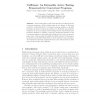173 search results - page 6 / 35 » Predicting the severity of a reported bug |
EUROSYS
2010
ACM
14 years 5 months ago
2010
ACM
Debugging real systems is hard, requires deep knowledge of the code, and is time-consuming. Bug reports rarely provide sufficient information, thus forcing developers to turn int...
CAV
2009
Springer
14 years 8 months ago
2009
Springer
Active testing has recently been introduced to effectively test concurrent programs. Active testing works in two phases. It first uses predictive off-the-shelf static or dynamic pr...
SIGSOFT
2010
ACM
13 years 5 months ago
2010
ACM
Empirical studies of software defects rely on links between bug databases and program code repositories. This linkage is typically based on bug-fixes identified in developer-enter...
TAP
2007
Springer
14 years 2 months ago
2007
Springer
Many static and dynamic analyses have been developed to improve program quality. Several of them are well known and widely used in practice. It is not entirely clear, however, how ...
CAV
2010
Springer
2010
Springer
Universal Causality Graphs: A Precise Happens-Before Model for Detecting Bugs in Concurrent Programs
13 years 10 months ago
Triggering errors in concurrent programs is a notoriously difficult task. A key reason for this is the behavioral complexity resulting from the large number of interleavings of op...

